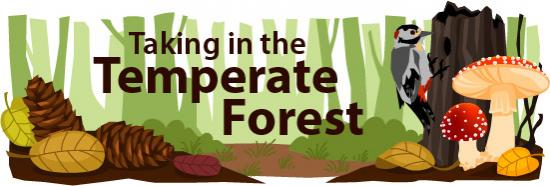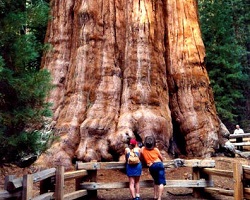show/hide words to know
Enzyme: a protein that changes the speed of chemical reactions.
Pigment: a natural chemical that reflects certain colors and absorbs others, giving color to a plant, animal, or object... more
Plants of the Temperate Forest
Trees are the most important plants in temperate forests. Most of the other organisms in the forest depend on the tree's ability to turn the sun’s energy into sugars using photosynthesis.
There are big trees and small trees. Some tree species like serviceberry, hop hornbeam, Dogwood, or Sassafras, never really get big enough to reach the canopy, and have relatively short lifespans.
The Big
Other trees like Oaks, Maples, Ponderosa Pines or Douglas-Fir, can live hundreds of years. Some Temperate Forest conifers like Redwoods and Giant Sequoias in California can live for thousands of years, and are some of the largest living things on the planet.
Big trees need a lot of water, which they absorb through their large root systems. They also need nutrients like nitrogen and phosphorus to make the enzymes and pigments (like chlorophyll) that they use in photosynthesis.
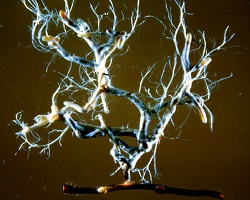
This root ball shows the roots in dark blue and the mycorrhizae in white. Image by B. Zak.
Though you can't see it, these trees take advantage of another organism to get nutrients from the soil. Almost all tree species use what are called mycorrhizae (meaning ‘fungus-roots’) to obtain some of their nutrients. These are roots which fungi have grown around or into.
The Small
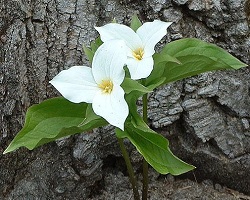
This small flowering white trillium can live for up to 70 years. Image by Dejo.
There are lots of other plants besides trees in temperate forests. Understory shrubs like Gooseberry (watch out for spines!) and Blueberry are some tasty examples.
And the Weird
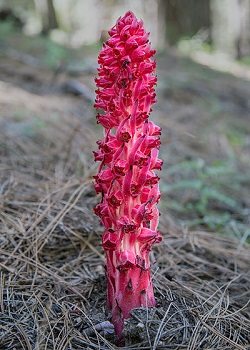
This pink, cylindrical snow plant steals nutrients from mycorrhizae on tree roots. Image by David Iliff.
There are also some stranger plants in the temperate forest. While you may picture plants as things with nice green leaves, there are some species of plants which are actually parasitic. That is, they steal nutrients or energy from other organisms.
Mistletoe is actually one of these plants. It grows high on the branches of other trees, where it steals water and nutrients from inside the tree’s branches. This way it doesn’t have to have roots in the ground.
Images via Wikimedia Commons. Dogwood image by Muffet.
View Citation
Bibliographic details:
- Article: Plants of the Temperate Forest
- Author(s): Drew Peltier
- Publisher: Arizona State University School of Life Sciences Ask A Biologist
- Site name: ASU - Ask A Biologist
- Date published: July 22, 2014
- Date accessed: April 17, 2024
- Link: https://askabiologist.asu.edu/plants-temperate-forest
APA Style
Drew Peltier. (2014, July 22). Plants of the Temperate Forest. ASU - Ask A Biologist. Retrieved April 17, 2024 from https://askabiologist.asu.edu/plants-temperate-forest
Chicago Manual of Style
Drew Peltier. "Plants of the Temperate Forest". ASU - Ask A Biologist. 22 July, 2014. https://askabiologist.asu.edu/plants-temperate-forest
Drew Peltier. "Plants of the Temperate Forest". ASU - Ask A Biologist. 22 Jul 2014. ASU - Ask A Biologist, Web. 17 Apr 2024. https://askabiologist.asu.edu/plants-temperate-forest
MLA 2017 Style

Some trees, like this dogwood, are called deciduous because they lose their leaves over the winter.
Be Part of
Ask A Biologist
By volunteering, or simply sending us feedback on the site. Scientists, teachers, writers, illustrators, and translators are all important to the program. If you are interested in helping with the website we have a Volunteers page to get the process started.







